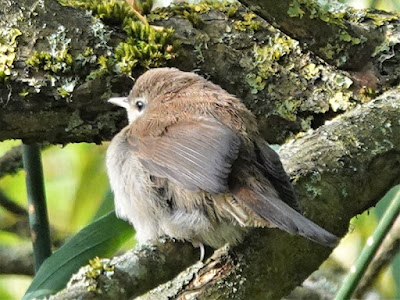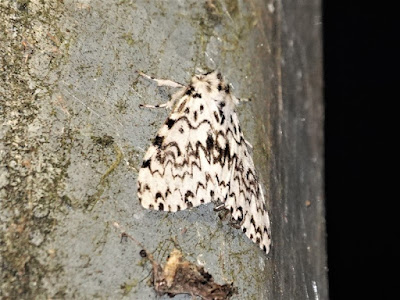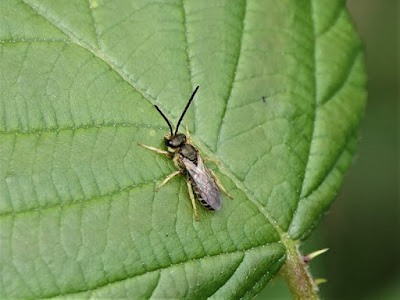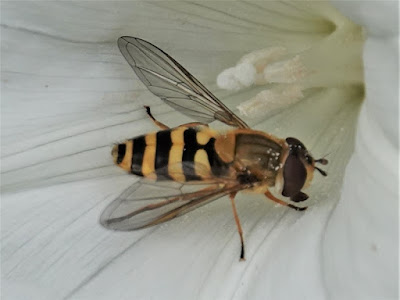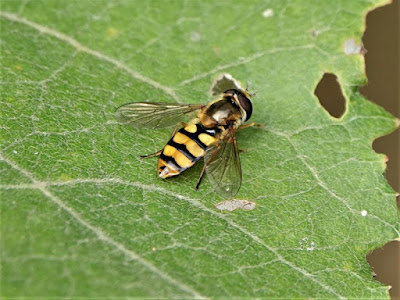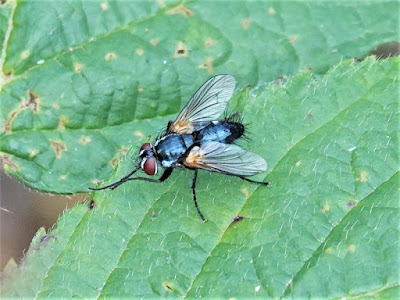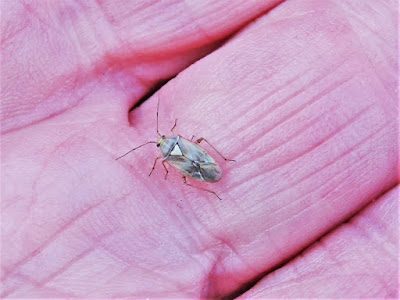13.0°C > 18.0°C: Some sunny intervals for a while: more cloud later. Light north-westerly breeze. Very good visibility.
Sunrise: 05:23 BST
* = a species photographed today
$ = my first sighting of the species for this year
$$ = my first ever recorded sighting of the species in the area
Priorslee Balancing Lake: 05:00 – 06:25 // 07:40 – 10:05
(184th visit of the year)
Bird notes:
- just one Greylag Goose when I arrived. I am not sure any had over-nighted: with the sailing club likely to have been on the water yesterday they may well have moved off. They did fly in later with eventually 59 Canada Geese and five Greylag Geese present.
- no obvious Mallard ducklings were noted.
- the duck Pochard seen again.
- a Tufted Duck was seen flying off East at 06:00
- four juvenile Great Crested Grebes noted: the brood of three was complete today (where has the third one been hiding). Just one other.
- the lone Blackbird was singing lustily at 05:05 and not heard thereafter.
- at least four Cetti's Warblers were seen and heard along the North side. Somewhat puzzling that most of the song heard earlier in the year was along the South side.
- a Willow Warbler was singing alongside Teece Drive c.06:20: a bird moving through on the long haul to sub-Saharan Africa.
- again small groups of Reed Warblers were seen. Today both in and away from the reeds.
Bird(s) noted flying over here:
- 10 Canada Geese: nine outbound in four groups; a single inbound
- 32 Greylag Geese: 15 outbound in five groups; 17 inbound in two groups
- 2 Stock Doves: singles
- 164 Wood Pigeons
- 1 Herring Gull yet again
- 7 Lesser Black-baked Gulls
- 141 Jackdaws
- 53 Rooks
Counts from the lake area:
- 59 Canada Geese: see notes
- 5 Greylag Geese: see notes
- 2 Mute Swans
- 25 (♂?) Mallard: see notes
- 1 (0♂) Pochard
- 1 (♂?) Tufted Duck: departed
- 11 + 6 (3 dependent broods) Moorhens
- 117 Coots
- 6 + 4 (2 broods) Great Crested Grebes: see notes
- 13 Black-headed Gulls: no juveniles
- 3 Lesser Black-baked Gulls
- 2 Grey Herons: one arrived
Hirundines etc. noted:
None
I assume the local Swifts have gone already. End-July is the usual date but the first flying ant hatch two weeks early they may well have fed well and left.
Warblers recorded (the figure in brackets is birds noted singing):
- *4+ (0) Cetti's Warblers
- 1 (1) Willow Warbler
- 12 (0) Chiffchaffs
- *9 (2) Reed Warblers
- 4 (0) Blackcaps
- no Common Whitethroat
Noted on the West end street lamp poles around-dawn:
I assume the local Swifts have gone already. End-July is the usual date but the first flying ant hatch two weeks early they may well have fed well and left.
Warblers recorded (the figure in brackets is birds noted singing):
- *4+ (0) Cetti's Warblers
- 1 (1) Willow Warbler
- 12 (0) Chiffchaffs
- *9 (2) Reed Warblers
- 4 (0) Blackcaps
- no Common Whitethroat
Noted on the West end street lamp poles around-dawn:
Moths:
- *1 Black Arches Lymantria monacha
- *1 Black Arches Lymantria monacha
Spiders, harvestmen etc.:
- 3 Bridge Orb-web Spiders Larinioides sclopetarius
- *1 Noble or False Widow Spider Steatoda nobilis
- *1 harvestman Dicranopalpus ramosus/caudatus
Noted later:
Hard going even with some sunny intervals
- 3 Bridge Orb-web Spiders Larinioides sclopetarius
- *1 Noble or False Widow Spider Steatoda nobilis
- *1 harvestman Dicranopalpus ramosus/caudatus
Noted later:
Hard going even with some sunny intervals
Butterflies:
Large White Pieris brassicae
Small White Pieris rapae
Green-veined White Pieris napi
*Speckled Wood Pararge aegeria
*Meadow Brown Maniola jurtina
*Gatekeeper Pyronia tithonus
Common Blue Polyommatus icarus
Large White Pieris brassicae
Small White Pieris rapae
Green-veined White Pieris napi
*Speckled Wood Pararge aegeria
*Meadow Brown Maniola jurtina
*Gatekeeper Pyronia tithonus
Common Blue Polyommatus icarus
Moths
4 Straw Grass-moth Agriphila straminella [was Straw Grass-veneer]
>5 unidentified grass moths, possibly all this species
1 Pale Straw Pearl Udea lutealis
*1 Common Carpet Epirrhoe alternata: species #76 here [another revision to the count!]
4 Straw Grass-moth Agriphila straminella [was Straw Grass-veneer]
>5 unidentified grass moths, possibly all this species
1 Pale Straw Pearl Udea lutealis
*1 Common Carpet Epirrhoe alternata: species #76 here [another revision to the count!]
Bees, wasps etc.:
Honey Bee Apis mellifera
Red-tailed Bumblebee Bombus lapidarius
Common Carder Bee Bombus pascuorum
Buff-tailed Bumblebee Bombus terrestris
Common Wasp Paravespula vulgaris
*$$ Yellow-legged Furrow Bee Halictus rubicundus
*$$ probable yellow-faced bee Hylaeus sp.
*female ichneumon probably Pimpla rufipes
Honey Bee Apis mellifera
Red-tailed Bumblebee Bombus lapidarius
Common Carder Bee Bombus pascuorum
Buff-tailed Bumblebee Bombus terrestris
Common Wasp Paravespula vulgaris
*$$ Yellow-legged Furrow Bee Halictus rubicundus
*$$ probable yellow-faced bee Hylaeus sp.
*female ichneumon probably Pimpla rufipes
Hoverflies:
Tapered Dronefly Eristalis pertinax
*Migrant Field Syrph Eupeodes corollae [Migrant Hoverfly; Migrant Aphideater]
*Meadow Field Syrph Eupeodes latifasciatus [Broad-banded Aphideater]
Tapered Dronefly Eristalis pertinax
*Migrant Field Syrph Eupeodes corollae [Migrant Hoverfly; Migrant Aphideater]
*Meadow Field Syrph Eupeodes latifasciatus [Broad-banded Aphideater]
Dragon-/Damsel-flies:
*Common Blue Damselfly Enallagma cyathigerum [Common Bluet]
*Common Blue Damselfly Enallagma cyathigerum [Common Bluet]
Four-winged flies – Lacewings, Caddisflies etc.:
none
none
Other flies:
*Scorpion Fly Panorpa sp.
*Tachinid fly Thelaira nigrina or similar
otherwise only unidentified fly species
*Scorpion Fly Panorpa sp.
*Tachinid fly Thelaira nigrina or similar
otherwise only unidentified fly species
Bugs etc.:
myrid bug Orthotylus sp.
myrid bug Orthotylus sp.
Beetles:
7 Spot Ladybird Coccinella 7-punctata
7 Spot Ladybird Coccinella 7-punctata
Amphibians:
none
none
Spiders, harvestmen etc.:
none
none
New plants for the year:
None
They remind me a bit of gonks. I think their fuzzy appearance indicates they are juveniles. I was unable to get a better angle to view them without twigs in the way.
Another species of warbler. One of a group of Reed Warblers jumping around and calling in the vegetation. This one burst in to song briefly.
Speckled Wood butterflies Pararge aegeria come in a range of browns with yellowish outlines to the circular marks. This one looks faded but lacks any sign of the wear and tear typical of this aggressive species so I think it must have "come like this".
With only one white dot in the black eye spot this is a Meadow Brown butterfly Maniola jurtina. It is a fresh-looking specimen: I had thought this species was near the end of its flight season.
Somewhat worn but showing that the Gatekeeper Pyronia tithonus has two white dots in the black eye spot.
This is probably a yellow-faced bee Hylaeus sp. which is somewhat annoying as I have never knowingly seen one of this genus before. There are twelve species recorded from the UK and the only way to identify them is by looking at their face. Not helpful here!
I noted very few hoverflies today. This is Migrant Field Syrph Eupeodes corollae and note the shape of the lower edge of the black bands as they curl around the edge of the abdomen.
This is a Meadow Field Syrph Eupeodes latifasciatus. Obsidentify calls it a Broad-banded Aphideater and note how the lower edge of the black bands on this species are horizontal.
A female Common Blue Damselfly Enallagma cyathigerum of the green form, here matured to a more greenish-brown colour.
The first Scorpion Fly Panorpa sp. I have seen for a while. I had thought their flight season had ended. Apparently not so.
The combination of orange bases to the wings; a white area on the side of the thorax; and very hairy abdomen suggest this is the Tachinid fly Thelaira nigrina or similar.
I am almost sure this is a Noble (or False) Widow Spider Steatoda nobilis. There are other similar-looking spiders in the genus but on size it has to be this species.
(Ed Wilson)
In the Priorslee Avenue tunnel:
A pair (I assume: you have to be careful these days) of Common Masoner moths Blastobasis adustella trying to ensure the continuation of the species.
(180th visit of the year)
Bird notes:
- no Mallard ducklings seen. I hope they were hiding in the reeds.
- back to four adult Great Crested Grebes. A pair at the top end again with no sign of the presumed juveniles in the water. The pair by the island with just two juveniles.
- a juvenile Common Buzzard was heard begging from trees at the top end and it, along with an adult, flew off.
- a Pied Wagtail was seen flying high East. This species has been scarce here this year.
Bird(s) noted flying over here:
- 4 Jackdaws: singles
- 1 Pied Wagtail
Noted on / around the water:
- 27 Canada Geese
- 7 Greylag Geese
- 6 Mute Swans
- 24 (?♂) Mallard
- 14 (?♂) Tufted Duck
- 3 Moorhens only
- 77 + 4 (3 dependent broods) Coots:
- 4 + 2 (1 brood) Great Crested Grebes: see notes
- 21 Black-headed Gulls: no juveniles
- 2 Lesser Black-backed Gulls: adults, briefly
Hirundines etc. noted:
Another chance to see... a Cetti's Warbler.
A slightly different angle on the same bird.
Two birds trying to hide.
And again.
Speckled Wood butterflies Pararge aegeria come in a range of browns with yellowish outlines to the circular marks. This one looks faded but lacks any sign of the wear and tear typical of this aggressive species so I think it must have "come like this".
A less-worn specimen. A female – the males have a dark area in the middle of the forewing.
Another from the "won't win prizes" file. My first Common Carpet moth Epirrhoe alternata this year.
My best-ever year for Black Arches moths Lymantria monacha in the area. Could do with more variety on the street lamp poles though.
A new species for me: a Yellow-legged Furrow Bee Halictus rubicundus.
There were two together: here is the other one. Yellow legs indeed.
An ichneumon wasp probably Pimpla rufipes. A female because of the ovipositor.
A female Common Blue Damselfly Enallagma cyathigerum of the green form, here matured to a more greenish-brown colour.
Probably my clearest shot yet of a harvestmen from the species pair Dicranopalpus ramosus/caudatus.
(Ed Wilson)
------------------------------------------------------------------------------------------------------
In the Priorslee Avenue tunnel:
Moths: [36 species here before today; no additions [one ID still pending]]
*2 Common Masoner Blastobasis adustella [was Dingy Dowd]
1 Dusky Pearl Udea prunalis : if the same as yesterday it had moved
1 Small Fan-footed Wave Idaea biselata
*2 Common Masoner Blastobasis adustella [was Dingy Dowd]
1 Dusky Pearl Udea prunalis : if the same as yesterday it had moved
1 Small Fan-footed Wave Idaea biselata
Flies:
*1 female Banded Mosquito Culiseta annulata
3 moth flies Psychodidae sp. [Drain Fly or Owl Fly]
11 midges of various species.
*1 female Banded Mosquito Culiseta annulata
3 moth flies Psychodidae sp. [Drain Fly or Owl Fly]
11 midges of various species.
Arthropods:
1 White-legged Snake Millipede Tachypodoiulus niger
1 White-legged Snake Millipede Tachypodoiulus niger
Spiders, harvestmen etc.:
spiders not identified
2 harvestman Opilio canestrinii
spiders not identified
2 harvestman Opilio canestrinii
A pair (I assume: you have to be careful these days) of Common Masoner moths Blastobasis adustella trying to ensure the continuation of the species.
As yesterday a female Banded Mosquito Culiseta annulata. And yes: she will use that proboscis to pierce your skin and take blood if she needs to. She won't give you malaria though.
(Ed Wilson)
The Flash: 06:30 – 07:35
(Ed Wilson)
------------------------------------------------------------------------------------------------------
The Flash: 06:30 – 07:35
(180th visit of the year)
Bird notes:
- no Mallard ducklings seen. I hope they were hiding in the reeds.
- back to four adult Great Crested Grebes. A pair at the top end again with no sign of the presumed juveniles in the water. The pair by the island with just two juveniles.
- a juvenile Common Buzzard was heard begging from trees at the top end and it, along with an adult, flew off.
- a Pied Wagtail was seen flying high East. This species has been scarce here this year.
Bird(s) noted flying over here:
- 4 Jackdaws: singles
- 1 Pied Wagtail
Noted on / around the water:
- 27 Canada Geese
- 7 Greylag Geese
- 6 Mute Swans
- 24 (?♂) Mallard
- 14 (?♂) Tufted Duck
- 3 Moorhens only
- 77 + 4 (3 dependent broods) Coots:
- 4 + 2 (1 brood) Great Crested Grebes: see notes
- 21 Black-headed Gulls: no juveniles
- 2 Lesser Black-backed Gulls: adults, briefly
Hirundines etc. noted:
None
Warblers recorded (the figure in brackets is birds noted singing):
- 6 (0) Chiffchaffs
- 2 (1) Blackcap
Noted around the area:
Warblers recorded (the figure in brackets is birds noted singing):
- 6 (0) Chiffchaffs
- 2 (1) Blackcap
Noted around the area:
Butterflies:
none
none
Moths [on street lamp poles and in the grass] [61 species here before today: no additions]
*1 Bird-cherry Ermine Yponomeuta evonymella
4 Straw Grass-moth Agriphila straminella [was Straw Grass-veneer]
*1 White Plume Pterophorus pentadactyla
1 Riband Wave Idaea aversata : same place as yesterday
*1 Bird-cherry Ermine Yponomeuta evonymella
4 Straw Grass-moth Agriphila straminella [was Straw Grass-veneer]
*1 White Plume Pterophorus pentadactyla
1 Riband Wave Idaea aversata : same place as yesterday
Bees, wasps etc.:
*Red-tailed Bumblebee Bombus lapidarius
*Common Carder Bee Bombus pascuorum
Buff-tailed Bumblebee Bombus terrestris
Common Wasp Paravespula vulgaris
*Red-tailed Bumblebee Bombus lapidarius
*Common Carder Bee Bombus pascuorum
Buff-tailed Bumblebee Bombus terrestris
Common Wasp Paravespula vulgaris
Hoverflies:
none
none
Dragon-/Damsel-flies:
none
none
Four-winged flies – Lacewings, Caddisflies etc.:
none
none
Other flies:
only unidentified fly species
only unidentified fly species
Bugs etc.:
*possible Tarnished Plant Bug Lygus rugulipennis
mirid bug Plagiognathus arbustorum
*possible Tarnished Plant Bug Lygus rugulipennis
mirid bug Plagiognathus arbustorum
Beetles:
none
none
Arthropods:
none
none
Spiders, harvestmen etc.:
4 harvestmen Dicranopalpus ramosus/caudatus
2 harvestmen Opilio canestrinii
4 harvestmen Dicranopalpus ramosus/caudatus
2 harvestmen Opilio canestrinii
New plant for the year
*$$ Common Fleabane Pulicaria dysenterica
I think this is a worn specimen of Bird-cherry Ermine Yponomeuta evonymella. There are other ermine species flying at the moment and separation using the subtle difference in the arrangement of the spots is key.
Another moth species having a good year is the White Plume Pterophorus pentadactyla. My second here with more seen previously at the Balancing Lake. I do not record it every year.
Bumblebees where visiting the relatively few remaining flowers around the waters' edge. Here a Red-tailed Bumblebee Bombus lapidarius
A bug in the hand is worth several in the bushes. Probably a Tarnished Plant Bug Lygus rugulipennis though there are – all together now – "several similar species".
A plant I have not logged previously is this Common Fleabane Pulicaria dysenterica. The genus part of the scientific name is derived from the Latin "pulex" meaning flea which it is supposed to repel. While the species name refers to its historic use to cure dysentery. I found this beside the small football field at the top end.
(Ed Wilson)
2012
Priorslee Lake
Grasshopper Warbler
(John Isherwood)
Nedge Hill
17 Mistle Thrush including several juveniles
(John Isherwood)
2006
Priorslee Lake
2 Common Terns
(Ed Wilson)
*$$ Common Fleabane Pulicaria dysenterica
I think this is a worn specimen of Bird-cherry Ermine Yponomeuta evonymella. There are other ermine species flying at the moment and separation using the subtle difference in the arrangement of the spots is key.
And here a Common Carder Bee Bombus pascuorum.
(Ed Wilson)
------------------------------------------------------------------------------------------------------
2012
Priorslee Lake
Grasshopper Warbler
(John Isherwood)
Nedge Hill
17 Mistle Thrush including several juveniles
(John Isherwood)
2006
Priorslee Lake
2 Common Terns
(Ed Wilson)

